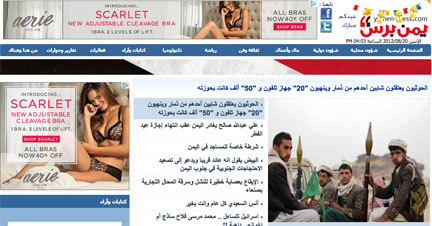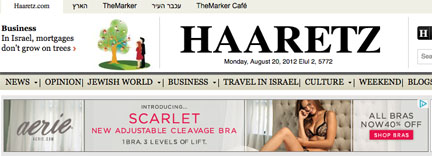
…

In attempting to keep up with the news in Yemen, I surf a number of Yemeni news sites. When I tried the usually reliable almasdaronline.com this morning, I was redirected to a commercial site called Mojo Pages. So I switched to yemen-press.com, where the top story was about the Huthi forces arresting two individuals in Sa‘da. While reading the article I realized that it was impossible to ignore the Gestalt of the total screen page, which I reproduce above. Here is a scene of several Yemeni fighters, clearly in a qat-chewing mode, and holding what I suspect (not being a military expert) are grenade launchers. What struck my attention was the advertisement adorning the banner and taking a prominent space on the left of the screen: Scarlet, the new adjustable cleavage bra. I have not been in the market for a bra, so I do not think the ad showed up due to any sophisticated Facebook-style marketing strategy. But I am male, so perhaps the assumption is that any Western viewer is in the market for a bra, since the ad is in English after all. And ten minutes later a new ad took its place: this time for a car rental place in New York.
Then a couple of hours later I happened across an article on Haaretz and there she was again: dear Scarlet hawking her gawking adjustable discount bra. Perhaps I am a victim of cookies twisting, but what a coincidence that is probably not a coincidence. Criss-crossing the endemic violence in the Middle East, the ongoing plight of the Palestinians and the voices in the Zionist wilderness of left-leaning Israelis there is the seductive power of an ad, as if politics did not really matter. In this case the bra fits all sizes of religious persuasions and the model is available to be ogled by anyone, at least from a Western computer. How ecumenical can commercial immodesty get.
It is the multifarious irony of these pages that weighs me down. I will focus on the Yemen website, since that was the first encounter with Scarlet. First, how ironic that I devour news by scouring multiple websites, most of which do not explicitly state their de facto bias. While there are a couple of Yemen News sites that are available in English (like Yemen Times and Yemen Post), they tend to be days old and in need of better English editing. Yemen Times, for example has a most recent post of August 15, five days ago, which is hardly Time Magazine timely. Yemen Post has a story only a day old, but its presentation is nowhere near as slick as any of the major Yemeni sites in Arabic. Irony #1 is that what is available but not in Arabic is old and out-of-date internet-wise. This is only an irony for the hubris with which English-speakers assume that news must be packaged in their native language.
The second irony is the critical crux. Where else can you find images of a seductive woman in a bra revealing cleavage (and at 40% off) counterposed with a truckload of qat-chewing Yemenis holding grenade launchers or on a major Israeli online newspaper in English? The images are in one sense lightyears apart: the woman in the ad has probably never met a Yemeni nor chewed qat; the fighters have not probably seen the cleavage of a model except in this kind of internet ad. Fashion does not discriminate, even at a discount. But who is this ad supposed to target? How many Westerners like me turning to the Yemen Press website are in the market for discounted bras, even if the ad is an ephemeral flash? I don’t know how many men would buy bras for Israeli women because of a Haaretz ad either. And who is likely to be most interested in the model’s cleavage-revealing pose? The ad makers assume that is me, even though I am looking for something quite different.
Sex sells; I know that because such a sales pitch has been slung at me since birth by a variety of media. The obvious was brought home to me some twenty years ago when I was in Istanbul working on manuscripts in the Ahmet III library. I had noticed that many of the Turkish newspapers I saw on the newsstands had pictures of young bikini-clad girls on the cover page. I asked a friend why there were so many tabloids in Turkey, but he told me that these were in fact the major newspapers and not tabloids. Somewhat naively confused, I asked why a serious newspaper would put a picture of an almost-naked woman on the cover and received a rather quizzical look before he said, “to sell the newspapers.” It is one of those “duh” moments that says much about the impact of media on who we think we are.
I am not sure if “sex sells” is really about discount bras, but it does raise the issue of what counts as “sex” in advertising. The selling point is fantasy, and sexual fantasy is a no-brainer in the seemingly secular West. Yesterday a former student sent me the url of a website with “Islamic Erotica,” an irony masquerading as an oxymoron. The artist has a painting of a Persian woman in hijab in front of a mosque in the famous Marilyn Monroe up-skirt pose (shown below).

Persian Marilyn Monroe by Makan Emadii
I immediately thought “what a fascinating website,” but was at a loss at how to write a post about it. Of course there are erotic Muslims, but mixing religion and sex is inevitably a dangerous business. But the Persian Marilyn Monroe fantasy is a telling visual metaphor about the world we all live in, including qat-chewing brethren in Sa‘da. What unites us, beyond the common humanity which is often left at an abstract level, is our common exposure to media-mediated representations of what we should buy, what we should look like, what we should think about. What is revealed by comparing the adjustable cleavage ad bra at top and the Marilyn sexy hijab pose is that we cannot escape such modern-day revelations no matter which Revelation a person’s religion holds as divine truth. There is no viable choice to simply tune out these messages any more than we could get rid of the microbes (or would want to if we realize what they actually do) in our bodies. Asceticism works fine when you can hole up in a cave, but global reality demands social contact. And social contact calls for a social contract, whether in the Enlightenment reasoning of Rousseau or any other world view that recognizes the world is full of meaningful differences.
All of this brings focus not to the image as a sexual object but the need to embrace the concept of modesty. The Qur’an (24:30-31) has a famous passage in which both men and women are told to avert their gaze if they see some enticing body part revealed. Literalists try to resolve this by blanketing women in cloth, as though not seeing flesh is the meaning of modesty. Yet, as the Persian Marilyn image suggests, there is still a flesh-and-blood person beneath the covering and lust is not necessarily averted by lack of a visual stimulation. Modesty is about intent. As a number of Sufi dervishes illustrated, one can be totally naked and be modest. What is disturbing about the bra ad is not the fact that a woman has a body, but that covering the breasts is all about fashion. Female breasts have been nurturing our human ancestors for several million years. What does it reveal about ourselves if we forget this fundamental fact of nature’s solution to nurturing? Perhaps we need to pay more attention to adjusting our sense of modesty than holding on to grenades for those we disagree with. I don’t think “sex sells” will bring peace to the Middle East, but any modest gain is a plus (and I do not mean sizewise).
Daniel Martin Varisco